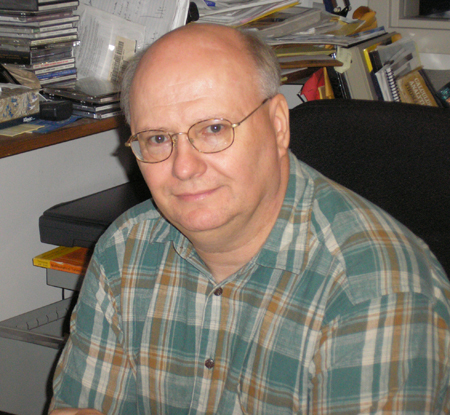Faculty: Eric W. Findsen, Ph.D.

Faculty Emeritus
Email: eric.findsen@utoledo.edu
Office: WO 2278
Phone: (419) 530-1506
Fax: (419) 530-4033
Professional Background:
B.S. 1980, Michigan State University
M.S. 1983, University of California, Riverside
Ph.D. 1987, University of New Mexico
Publications
Research Synopsis: Biophysical Chemistry, Physical Chemistry, Analytical Chemistry:
Raman and time-resolved Raman spectroscopy of metalloporphyrins, related macrocycles,
and protein systems.
Metalloporphyrins are pervasive in nature. They play important, key roles in many
processes such as electron transfer, oxygen transport and storage, and conversion
of light into chemical energy. They are also coming into prominence as components
in alternate energy systems. While it is clear that reactivity of these macrocyclic
systems is very sensitive to the immediate environment, this dependence is not well
understood.
My research interests center around the use of spectroscopic techniques to study the
physical properties of metalloporphyrins and related macrocyclic compounds, and how
those properties are modulated by the surrounding protein or solvent environment.
My research interests resolve into four basic areas:
1) The excited state behavior of porphyrins and related molecules and the effect of
the solvent environment upon their excited states;
2) Electron transfer mechanisms in metalloporphyrins, both in and out of protein systems;
3) The more difficult and long term question of how a porphyrin's reactivity is modulated
by the protein matrix surrounding it in proteins such as myoglobin, hemoglobin, and
cytochrome c;
4) The application of gathered information to problems such as energy collection and
storage, hematoporphyrin photodynamic therapy, and protein structure-function relationships.
My group uses many spectroscopic techniques to probe the effects of environment upon
metalloporphyrin reactivity. The primary spectroscopic tool used in this research
will be resonance Raman spectroscopy. Some of the other techniques which will be employed
include Infrared, Electron Spin Resonance, Fluorescence, and Optical Absorption spectroscopies.
Resonance Raman spectroscopy is a very sensitive technique which can be used to study
the vibrational and electronic response of a chromophore at equilibrium and after
perturbation. Often the excited state properties of a molecule like a porphyrin are
much more sensitive to environmental factors than those of the ground state molecule.
Transient and time resolved resonance Raman spectroscopy can provide detailed information
concerning the vibrational and electronic dynamics of a molecular system. Pulsed lasers
are used to probe the molecular system at discrete time delays after optical excitation
with a pump laser pulse. This laboratory has a Nd:YAG laser system capable of producing
high power pulses with either 20 ps or 10 ns wide pulses. Information gained by other
time resolved techniques such as transient absorption and time resolved fluorescence
spectroscopies. Development of instrumentation, electronics, and techniques to improve
the sensitivity, resolution, and applications of Raman spectroscopy are also strong
components of the research efforts of this laboratory.


